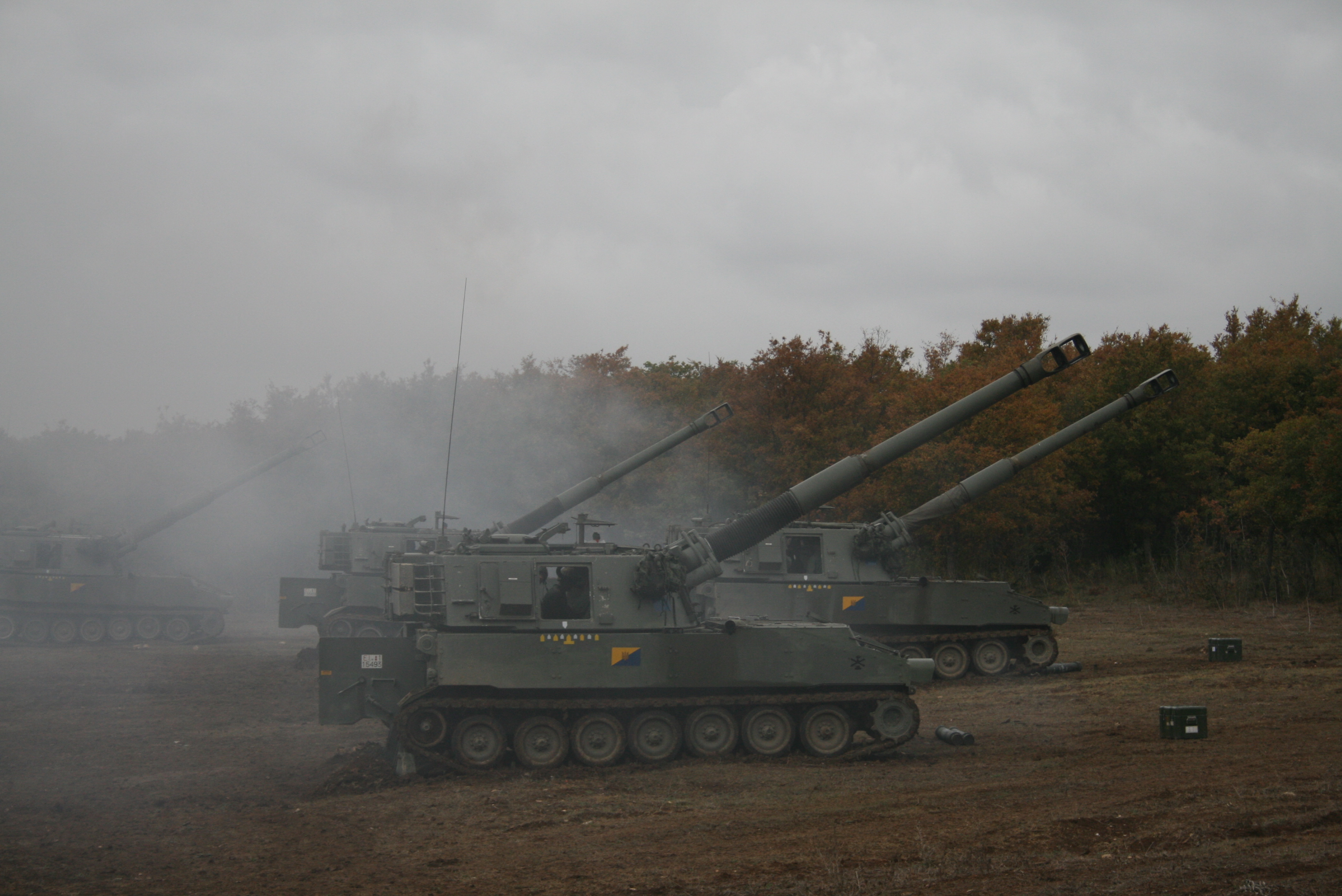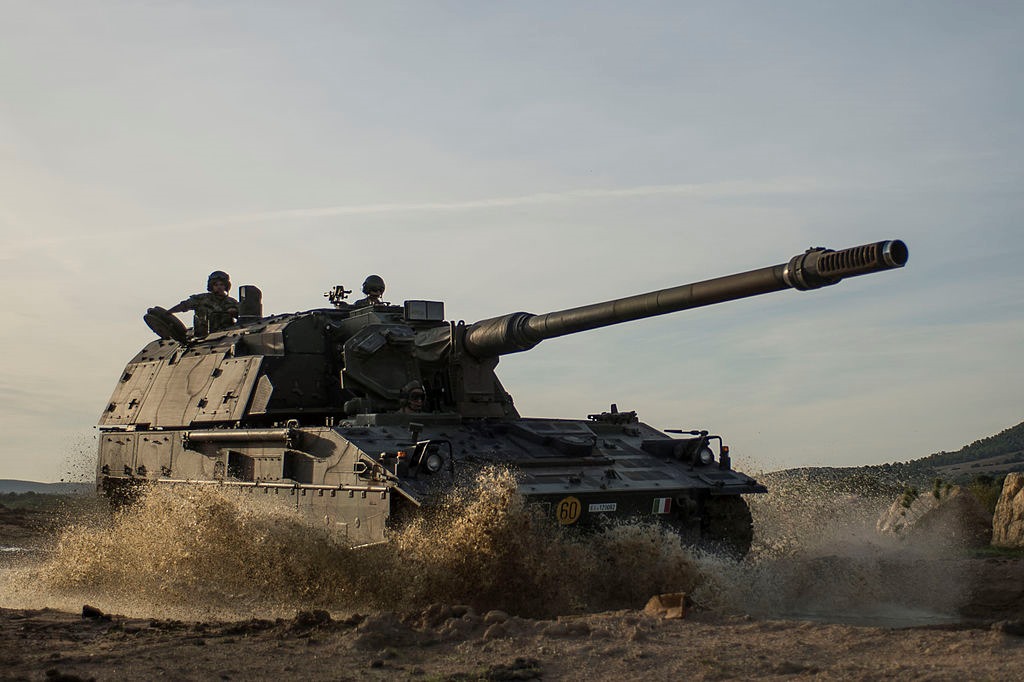
An M109L battery of the Iralian 52th Regiment firing, October 30, 2007. By Wikimedia user Totonninix.
Italy supplied “20 to 30” M109L 155 mm self-propelled howitzers to Kiev forces as part of its fifth military aid package to Ukraine, the La Repubblica newspaper reported on October 30.
The M109L is an Italian-made development of the American M109 howitzer. The M109L was upgraded with a 39 caliber long-barrel gun to replace the original 23 caliber barrel of the American M109. The new gun can fire the same projectiles as the Italian FH-70 howitzer. It has range of 24 kilometers with L15 HE projectiles, or up to 30 kilometers with assisted ammunition.
Just a few days before the report, photos showing a number of M109L howitzers on the move in northern Italy surfaced online.
The La Repubblica revealed that previous Italian military aid packages to Ukraine included an unknown number of M113 armored personnel carriers, six PzH 2000 155 mm self-propelled howitzers and two multiple launch rocket systems (MLRS).
“This is a significant contribution, first of all, from a technological point of view, as two of the most powerful and modern combat systems currently available were transferred. These include the PzH 2000 ACS and MLRS, which allowed Ukrainian troops to surpass the Russian artillery,” the newspaper said.
The PzH 2000 has a maximum range of 30–36 kilometers with the standard DM121 Boattail round, about 40–47 kilometers with base bleed rounds, and 67 kilometers with M2005 V-LAP assisted projectiles. It can also fire the SMArt 155 shell which carries two anti-tank submunitions with infrared sensor and millimeter wave radar.
The specific kind of Italian MLRS supplied to Ukraine is unknown, but it is likely the American M270. At least 22 such systems are said to be in service with the Italian military, part of which were upgraded to launch precision-guided GMLRS rockets with a range of more than 70 kilometers.
In the last few months, Kiev forces received dozens of similar howitzers and rocket systems from the United States and several other NATO members. At least some of these weapons have been already destroyed or damaged by the Russian military.
The NATO has been working to prolong the war in Ukraine on the hopes of preventing Russia from achieving the goals of its special military operation in the country. Ukraine continues to pay a heavy cost for this strategy.
MORE ON THIS TOPIC:










It’s almost as if the Euro elite want to disarm their armies so that they are unable to blow their own noses without American say-so.
They are scum,Italians and some of the other Euro trash are making the same mistake they made when they sided with Hitler,slow learners.
Russia will soon have no choice and must get its submarines as close to the coasts of the USA, England and Israel as possible and launch so many nukes that the rest of the world will be paralyzed and enter into serious peace agreements with Russia in this new era that lies ahead .
China and North Korea will gladly take on the task of disarming the functional nuclear weapons remaining in the United States.
All countries must prohibit the surviving, radioactive peoples from leaving the destroyed areas and leave them to their own fate.
Israel isn’t even in the question, their soldiers are getting ran over by Palestinians. No one takes israel seriously anymore, it isn’t 1967
It is necessary to be so fast that no one has time to use their own nuclear bomb.
But I also see that Israel must use its nuclear bombs on its own territory and choose to die together with many advancing Palestinians.
But we will see who reacts first, Russia or the Palestinians.
In any case, Israel has no chance of winning with England and the United States as broken countries.
If Russia wants to end the war, they will announce a second even larger mobilization. The West, knowing that Ukraine will begin losing territory again, will seek terms. The mobilized will be in their own beds within a month.
I think that could happen,i would mobilse at least another half million.
Italy, first they helped steal an election for Biden the undead zombie lord, and now they’re tossing shit weapons at a lost war… No air power, no defence, these weapons will be destroyed and in some cases, captured. Pizza stains, that’s all that will be left of those slow poke weapons…
Hope to see Zelensky and his wife and all of the Ukronazis paraded naked in the Red Square, in January, after all the weapons sent by NATO scum and captured by the Mighty Russian Army.
🇷🇺
Thank you. I don’t want to see Zelenski naked, just dead. He can keep his military t-shirt.
We already have seen him naked so why waste good clothes on the warmongering scum?
Just earlier the Italians protested and declared themselves against these weapon deal… Seems also the new PM gives a shit about what the Italians want and just obeys and follows orders like all the EU politicians these days…
Good. Those bombs will explode on the head of Russian servicemen.
Thanks to Putin , Slavs murdering Slavs. Going the good way.
Thanks to Ukro-nazis who killed 14.000 Russians (citizens of Ukraine) since 2014, before Russian intervention.
thats like +- 1000 per year death toll. now it’s like 200.000 people dead in 6 months lol. putin going the good way. murdering his slav brothers and sisters like its a daily thing to do like eating and pooping.
That filth with a vagina that has stolen the position of prime minister is a Soros scum just like all EU “dignitaries” and would-be “officials”.
Official pieces of shit, turds and scumbags!
An expensive donation for Italy. Where is the money coming from for replacements?
With the Vatican’s riches, they can pay whatever it takes.
Not everyone is aware that the Pope alone can order all Catholics into military service and start wars.
Spaguetis Itakas should be punished for that
Mussolini country, allied of the Nazi Germans back then. Allied of the Nazi Ukraine 70 years later. Some people never learn.
Italian people are against this.
All Italians are thiefs.
It is quite impressive to see how Russia continues to win even when they have to fight against NATO’s mercenaries and equipment. I just have to give credit when it’s due.
Sorry italy you vote again for a US puppet
Whats worse than garbage?
Italian garbage….
Ukraine soldiers and regular US and UK soldiers pretend dressing as Ukraine soldiers have been suffering from many losses of life,sad US and UK will send their widows and daughters as prostitutes and sex slaves to US and UK.
Destroy all those weapons while they are still in Italy and all the other NATO countries.
Winter is coming but the Russian soldiers will be kept warm by the Italian howitzers.
your mothers arse will kept warm after my visit.
In geopolitical terms, Italy peaked in the 1980s with the synthetic pop band Fun Fun.
this ist still and ongoing the main weak point on the ukro front.
if russia dont destroy all western supply routes, nato will go on with pumping in all what they have into ukraine.